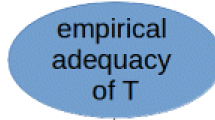Abstract
The no miracles argument is one of the main arguments for scientific realism. Recently it has been alleged that the no miracles argument is fundamentally flawed because it commits the base rate fallacy. The allegation is based on the idea that the appeal of the no miracles argument arises from inappropriate neglect of the base rate of approximate truth among the relevant population of theories. However, the base rate fallacy allegation relies on an assumption of random sampling of individuals from the population which cannot be made in the case of the no miracles argument. Therefore the base rate fallacy objection to the no miracles argument fails. I distinguish between a “local” and a “global” form of the no miracles argument. The base rate fallacy objection has been leveled at the local version. I argue that the global argument plays a key role in supporting a base-rate-fallacy-free formulation of the local version of the argument.
Similar content being viewed by others
Notes
This example is cited in (Howson 2000, p. 52), as a problem which was actually given to students and staff at Harvard Medical school.
Psillos’ attempt to reconstruct the NMA in likelihoodist terms (Psillos 2006) similarly yields too weak a conclusion, as pointed out in (Howson 2013). In the context of the positivist versus realist dispute, Dorling discusses conditions under which the accumulation of ordinary observational evidence may move someone with a low prior for realism by Bayesian conditionalisation to the realist position, though he is not specifically concerned with the NMA (Dorling 1992).
Notably, however, in variants of the experiments, where subjects do the random sampling themselves, base rate neglect is substantially diminished (Gigerenzer 1991).
Magnus and Callender also consider the possibility that in order to assess the prior probability for T the realist could take the set of theories \(\mathcal {{H}}\) ‘actually professed by our mature sciences’, then ‘sample the overt declarations of mature sciences and check their success’ (Magnus and Callender 2004, p. 326). However, they reject this possibility, saying ‘this would be a biased sample, since theories in mature sciences were chosen (in no small part) because they were successful. Any theory [in \(\mathcal {{H}}\)] would probably be successful, just on account of its membership in \(\mathcal {{H}}\)’ (Magnus and Callender 2004, p. 326). Magnus and Callender then say that this route to avoiding base rate neglect is only accomplished ‘at the cost of sample selection bias’. However, Magnus and Callender’s objection rests on not clearly distinguishing between success at different times. The set of theories under consideration is the set of those which are best-confirmed in their fields. It is true that all those theories have been successful in the past. But the question at issue in the global NMA is whether they continue to succeed when tested in novel ways. There is no guarantee that a theory which succeeded before will go on succeeding, rather than needing to be replaced in substantive ways. Thus Magnus and Callender’s statement that any best confirmed theory would trivially be successful by virtue of its membership in the set \(\mathcal {{H}}\) is not true.
Interestingly, similar moves were already made by Fine (1991). Fine suggested that realists might take refuge in a ‘piecemeal’ defence of their position, given that, as he saw it, the NMA was fundamentally flawed because of circularity. Fine actually concluded that the piecemeal approach was equally unpromising, famously leading to a general recommendation to dissolve the realism debate altogether (Fine 1984).
References
Boyd, R. N. (1983). On the current status of the issue of scientific realism. Erkenntnis, 19, 45–90.
Dorling, J. (1992). Bayesian conditionalization resolves positivist/realist disputes. The Journal of Philosophy, 89, 362–382.
Fine, A. (1984). The natural ontological attitude. In J. Leplin (Ed.), Scientific realism (pp. 83–107). Berkeley: University of California Press.
Fine, A. (1986). Unnatural attitudes: Realist and instrumentalist attachments to science. Mind, 95, 149–179.
Fine, A. (1991). Piecemeal realism. Philosophical Studies, 61, 79–96.
Gigerenzer, G., Eells, E., & Maruszewski, T. (1991). On cognitive illusions and rationality. Probability and rationality: Studies on L. Jonathan Cohen’s philosophy of science (pp. 225–250). Amsterdam: Rodopi.
Howson, C. (2000). Hume’s problem: Induction and the justification of belief. Oxford: Oxford University Press.
Howson, C. (2013). Exhuming the no-miracles argument. Analysis, 73(2), 205–211.
Kahneman, D., & Tversky, A. (1973). On the psychology of prediction. Psychological Review, 80(4), 237–251.
Laudan, L. (1981). A confutation of convergent realism. Philosophy of Science, 49, 19–49.
Lipton, P. (2004). Inference to the best explanation (2nd ed.). London: Routledge.
Magnus, P. D., & Callender, C. (2004). Realist ennui and the base-rate fallacy. Philosophy of Science, 71, 320–338.
Musgrave, A. (1988). The ultimate argument for scientific realism. In R. Nola (Ed.), Relativism and realism in science (pp. 229–252). Dordrecht: Kluwer Academic Publishers.
Psillos, S. (1999). Scientific realism: How science tracks truth. New York: Routledge.
Stathis, P. (2006). Thinking about the ultimate argument for scientific realism. In C. Cheyne & J. Worrall (Eds.), Rationality and reality: Conversations with Alan Musgrave (pp. 133–156). Berlin: Springer.
Putnam, H. (1975). Mathematics, matter and method. Cambridge: Cambridge University Press.
van Fraassen, B. C. (1980). The scientific image. Oxford: Oxford University Press.
Worrall, J. (2005). Miracles, pessimism and scientific realism. LSE webpage.
Acknowledgments
I would like to thank Agustín Rayo, Robert Stalnaker and Roger White for discussion of early versions of this paper.
Author information
Authors and Affiliations
Corresponding author
Rights and permissions
About this article
Cite this article
Henderson, L. The no miracles argument and the base rate fallacy. Synthese 194, 1295–1302 (2017). https://doi.org/10.1007/s11229-015-0995-7
Received:
Accepted:
Published:
Issue Date:
DOI: https://doi.org/10.1007/s11229-015-0995-7




